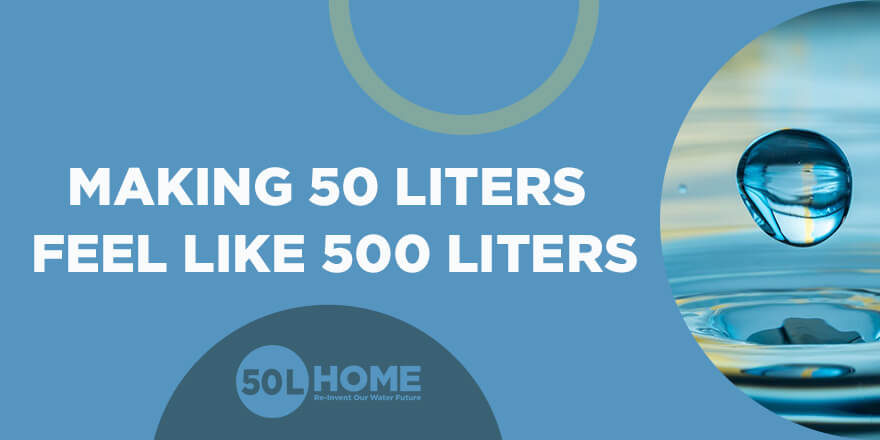50L Home Coalition: Ending our dependence on freshwater for urban sanitation systems
The world is facing an urban water crisis: 70% of the world’s 20 megacities are already experiencing water scarcity or droughts – disrupting business, exacerbating inequalities, and threatening health. Cities worldwide face the risk of looming “Day-Zero” – the day when water sources run dry. One example is Cape Town, South Africa, which had to ration its water consumption to 50 liters (L) per day per person. In contrast, the average per capita household water use is highly inefficient – at 150 L to 500 L per person each day, using drinkable water to flush toilets as well as drain water from showers and washing machines into sewages.
The world is also facing climate change because of increased greenhouse gas (GHG) emissions. Most domestic water is heated for showering, handwashing, dishwashing, shaving, and laundering. Heating the water is the second-highest source of GHG emissions after heating the home itself, contributing to 16% of total energy use.
50 Liter Home (50LH) is an inspiration and ambition to help solve two of the world’s most pressing challenges: water security and climate change. 50LH aims to reinvent sustainable home-living and make it an irresistible aspiration for all. It will do so right in people’s homes by creating innovative, sustainable solutions that bring down daily per capita water consumption in the home from as high as 500 L per day, while making 50 L of daily water use per person feel like 500 L. To this end, there have been several innovative technologies, regulations, and consumer campaigns over the last decade or so that aim to reduce or remove the need for water.

To take the example of toilet use, water efficiency product labeling plays an important role in informing consumers. A recent study highlighted that many well-established labels deliver quantifiable water and energy savings as well as reduce customer bills. The WaterSense label, a voluntary partnership program sponsored by the U.S. Environmental Protection Agency (EPA), has shown how if inefficient toilets in the United States are replaced with WaterSense-labeled models, there could be savings of 360 billion gallons (or 1.6 billion m3) of water per year. From a technology perspective, the Bill & Melinda Gates Foundation has been instrumental in catalyzing innovation through their Reinventing the Toilet challenge, which has led to the commercialization of a number of no- to low-water toilets in developed and developing countries. And considering that today, 4.2 billion people are living without access to safely managed sanitation, we must ensure that urban systems are designed to meet these basic needs and at the same time reduce dependencies on good quality water.
While these approaches to reducing and removing the need for water have led to incremental reductions in household water consumption, it is reuse in the home that offers transformational opportunities. A recently published paper from research funded by the Gates Foundation demonstrated the effectiveness of technologies to recycle water from hand washing and toilet flush water in real-life applications. But as is often the case, while the technology is effective, there are broader systemic issues that need to be addressed for widescale deployment, and these are the kind of issues that 50LH is tackling. There are several critical perspectives to look at:
- With lower flows into and out of homes, what is the impact of low- or no-water products on existing centralized urban water supply and sewerage systems?
- What are the key value drivers for consumer behavior change for the widespread adoption of products that reuse water or use less water?
- What is required in terms of standards, regulations, norms, and product labeling for reusing water in the home?
- How to incentivize real estate developers and investors to adopt 50LH concepts in construction projects?
- How do we connect and reuse water across the home: laundry, bathroom, and kitchen?
Responding to these questions requires unusual partnerships, new thinking, and in situ testing, all things that 50LH aims to facilitate. It is a desperate fact that two-thirds of the global population does not have access to safely managed sanitation, and we echo calls made by world leaders to prioritize water, sanitation, and hygiene interventions.
As such, 50LH is backed by a coalition to help turn it into reality. Launched on October 27, 2020, 50LH is spearheaded by Procter & Gamble and supported by the World Economic Forum (WEF), 2030 Water Resources Group, and World Business Council for Sustainable Development. The Coalition is led by a pioneering group of private sector, public sector, and civil society representatives, including Arcadis, Electrolux, Kohler, and Suez.
The Coalition aims for a transformation and system-change over the entire water value chain, behind 4 key deliverables:
- Education: reshaping people’s relationship with, and the value of, water
- Innovation: developing solutions to make 50L feel like 500L inside the home and within the wider urban water system
- Regulation: advancing policy, regulatory, and industry frameworks
- Implementation: launching pilots in water-stressed cities that mobilize local stakeholders and financing
50LH was selected by WEF as one of the top 100 Lighthouse Projects in 2020 for Social, Environmental, and Governance Impact. It works toward United Nations Sustainable Development Goals 6 (clean water and sanitation), 11 (sustainable cities and communities), 12 (responsible consumption and production), and 13 (climate action).
While many projects focus on rural access, 50LH is unique in tackling the urban conservation of water, at a worldwide scale, and as a system-change, recognizing that cities will host 60% of the population by 2030 and generate 70% of CO2 emissions worldwide.*
Most importantly, 50LH is novel in its 100% user-centric design approach, inventing for circular residential water consumption starting from the very inside of our homes, stemming from people’s needs and desires across the various points of use (showers, faucets, appliances) – all the way to the outside sewages, municipal treatment, and re-treatment infrastructures.
*Reference: https://www.c40.org/ending-climate-change-begins-in-the-city
